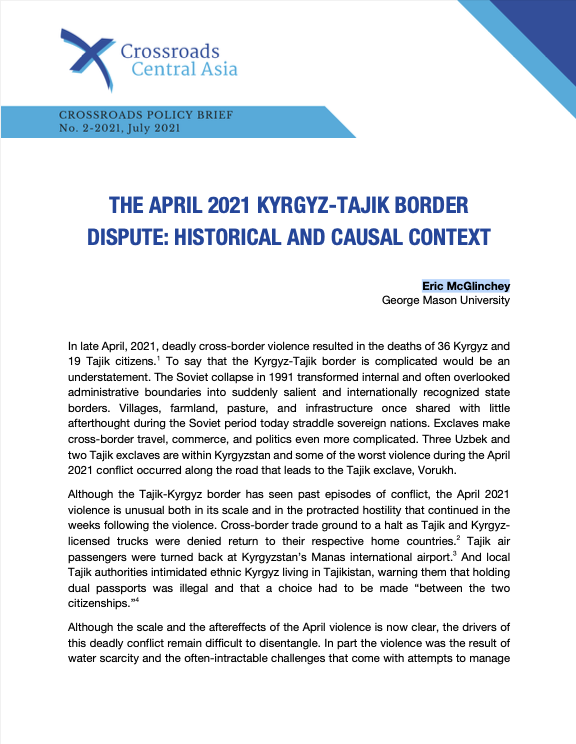In late April, 2021, deadly cross-border violence resulted in the deaths of 36 Kyrgyz and 19 Tajik citizens.1 To say that the Kyrgyz-Tajik border is complicated would be an understatement. The Soviet collapse in 1991 transformed internal and often overlooked administrative boundaries into suddenly salient and internationally recognized state borders. Villages, farmland, pasture, and infrastructure once shared with little afterthought during the Soviet period today straddle sovereign nations. Exclaves make cross-border travel, commerce, and politics even more complicated.
Search results
Showing items 1 through 9 of 194.-
Library ResourceReports & ResearchJuly, 2021Kyrgyzstan, Tajikistan
-
Library Resource
Factors and actors driving the reform agenda
Journal Articles & BooksJuly, 2017Central Asia, Kazakhstan, Kyrgyzstan, Tajikistan, Turkmenistan, MongoliaThis paper examines the roles of the state, international organisations and the public in pastoral land reform in the Central Asian republics and Mongolia. In recent years new legislation has been passed in most of these countries, often driven by environmental concerns. In the development of these laws, international organisations tend to promote common property regimes, whilst governments usually emphasise individual security of tenure, each using environmental arguments taken from quite different bodies of theory.
-
Library ResourceJournal Articles & BooksJuly, 2010Tajikistan
This paper looks at how recent economic and legal changes have affected pasture management and property rights in Tajikistan. Firstly, current trends in livestock numbers and mobility are compared with those of the Soviet period. Secondly, the impact of current land legislation is investigated using 2007 field data from two sites in the Gorno-Badakhshan region of the country. We describe the extent to which pasture at these sites is under private, community or state control and discuss the implications for sustainable management of this resource.
-
Library ResourceJournal Articles & BooksSeptember, 2007Tajikistan
This article uses data from household income surveys to look at income structures amongst households in three mountainous regions of Tajikistan: Gorno-Badakhshan, the Rasht Valley and Eastern Khatlon. The structure of incomes demonstrates the dominant role of subsistence agriculture in all three regions although commercial agriculture is important amongst better-off households in Rasht. Relationships between poverty and household characteristics including access to capital, demographic variables and income-generating activities were examined.
-
Library ResourceJournal Articles & BooksJanuary, 2008Tajikistan
This paper examines the impact of land reform on agricultural productivity in Tajikistan. Recent legislation allows farmers to obtain access to heritable land shares for private use, but reform has been geographically uneven. The break-up of state farms has occurred in some areas where agriculture has little to offer but, where high value crops are grown, land reform has hardly begun. In cases where collectivized farming persists and land has not been distributed, productivity remains low and individual households benefit little from farming.
-
Library ResourcePolicy Papers & BriefsJune, 2021Kenya, Angola, Chad, Liberia, Senegal, Sierra Leone, Guatemala, Kyrgyzstan, Tajikistan, Afghanistan, Bangladesh, Bhutan, India, Pakistan, Global
June 4, 2021 -- An increasing number of countries are facing growing levels of acute food insecurity, reversing years of development gains. Even before COVID-19 reduced incomes and disrupted supply chains, chronic and acute hunger were on the rise due to various factors including conflict, socio-economic conditions, natural hazards, climate change and pests. COVID-19 impacts have led to severe and widespread increases in global food insecurity, affecting vulnerable households in almost every country, with impacts expected to continue through 2021 and into 2022.
-
Library Resource
Local sustainable development solutions for people, nature, and resilient communities
Reports & ResearchDecember, 2012TajikistanLocal and indigenous communities across the world are advancing innovative sustainable development solutions that work for people and for nature. Few publications or case studies tell the full story of how such initiatives evolve, the breadth of their impacts, or how they change over time. Fewer still have undertaken to tell these stories with community practitioners themselves guiding the narrative. The Equator Initiative aims to fill that gap.
-
Library Resource
Local sustainable development solutions for people, nature, and resilient communities
Reports & ResearchDecember, 2012TajikistanLocal and indigenous communities across the world are advancing innovative sustainable development solutions that work for people and for nature. Few publications or case studies tell the full story of how such initiatives evolve, the breadth of their impacts, or how they change over time. Fewer still have undertaken to tell these stories with community practitioners themselves guiding the narrative. The Equator Initiative aims to fill that gap.
-
Library Resource
Consequences for Tenure Security, Agricultural Productivity and Land Management Practices
Journal Articles & BooksJanuary, 2008TajikistanThis paper examines the impact of land reform on agricultural productivity in Tajikistan. Recent legislation allows farmers to obtain access to heritable land shares for private use, but reform has been geographically uneven. The break-up of state farms has occurred in some areas where agriculture has little to offer but, where high value crops are grown, land reform has hardly begun. In cases where collectivized farming persists and land has not been distributed, productivity remains low and individual households benefit little from farming.
-
Library ResourceReports & ResearchDecember, 2014Tajikistan
After more than two decades of agrarian change in Tajikistan, farming structures seem to crystallise. The first signs towards farm individualisation were observed only around 2000, which were the result of significant pressure from outside, when the post-conflict state was highly susceptible to pressure from multilateral institutions. Over time, striking differences in agrarian structures have emerged nation-wide; from highly fragmented, autonomous farms, to elite-controlled large-scale cotton farming.
Land Library Search
Through our robust search engine, you can search for any item of the over 64,800 highly curated resources in the Land Library.
If you would like to find an overview of what is possible, feel free to peruse the Search Guide.










